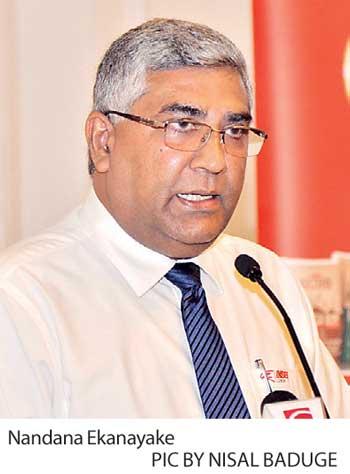24 Jul 2019 - {{hitsCtrl.values.hits}}
 By Nishel Fernando
By Nishel Fernando
Sri Lanka’s cement demand is expected to rebound by 3-4 percent this year, indicating a construction sector recovery after demand contracted by five
percent last year.
“During the first half of the year, we had a marginal positive growth of around 4 percent, though cement demand contracted in March and April,” INSEE Cement Chairman/CEO Nandana Ekanayake told Mirror Business on the sidelines of the launch of the firm’s ‘Sustainability Report 2018’ in Colombo yesterday.
Siam City Cement (Lanka) Ltd., known as INSEE Cement, which is a member of the Siam City Cement Public Company Ltd (SCCC) in Thailand, has the leading market share in Sri Lanka’s cement market.
Even though, the cement demand is recovering, he noted that the demand is growing well below what it was during the post-war period.
“As a small country, we need to have a higher growth, because in absolute terms, it’s not much. We had 15-16 percent growth in some years in the post-war period,” he added.
Sri Lanka’s construction industry grew 6.9 percent during the first quarter of this year.
Ekanayake was hopeful that the current recovery in cement demand would remain for the remainder of the year despite the negative economic impacts stemming from Easter
Sunday attacks.
SCCC had earlier projected Sri Lanka’s cement demand to grow by one percent this year over the previous year.
However, he expressed concerns over the slowdown in new projects following the Easter Sunday attacks.
“During last few months, there has been a slowdown in new projects. Even investors who have had plans, had stepped back a little. We need to have continuous pipeline of projects coming in,” he said.
The recovery is expected to be driven by short-term small-scale projects due to upcoming elections. However, the house building sector has slowed down due to high interest rates.
Further, slow progress of key infrastructure projects such as Colombo Port City, Central Expressway have also contributed to the slow growth in cement demand.
On a positive note, the B2B cement demand has been picking up from the past few months after slowing down in the first quarter of the year.
The SCCC has projected around 3 percent average growth in the cement demand in Sri Lanka until 2022.
However, Ekanayake remarked that if early elections are held, the cement demand could rebound to double digit levels by the second half of next year.
The sale volumes of INSEE Cement declined from 2.2 million tonnes in 2017 to 2.1 million tonnes in 2018 despite claiming to have retained the highest market share of 35 percent in Sri Lanka.
The political disturbances mainly contributed to a 5 percent decline in cement demand in Sri Lanka, last year.
SCCC has invested around US$ 47 million for capacity expansions and new product solutions, following its acquisition of Holcim Lanka in 2016. INSEE Cement Lanka plans to increase its market share from the current 35 percent to around 40 percent by end of this year.
The company last year launched its new vertical cement grinding plant in Galle which boosted its capacity by 0.4 million tons per year, as INSEE Concrete (ready-mixed) Peliyagoda operations started during the same year.
Currently, INSEE Cement Lanka produces 2.7 million tonnes per annum and also runs a cement importing terminal in Colombo with a capacity of 800,000 tonnes per annum.
The company also spun off its sustainable waste management arm, Ecocycle as a separate legal entity called INSEE Ecocycle Lanka (Private) Limited. Ecocycle has helped Insee Cement to substitute 34 percent of sourcing of coal with sustainable waste management solutions.
INSEE Cement and Tokyo Cement together currently hold around 67 percent of the Cement market in Sri Lanka, while Ultratech, Singha Cement (Heidelberg) and bag importers hold the remaining 33 percent.
15 Nov 2024 19 minute ago
15 Nov 2024 32 minute ago
15 Nov 2024 44 minute ago
15 Nov 2024 1 hours ago
15 Nov 2024 2 hours ago